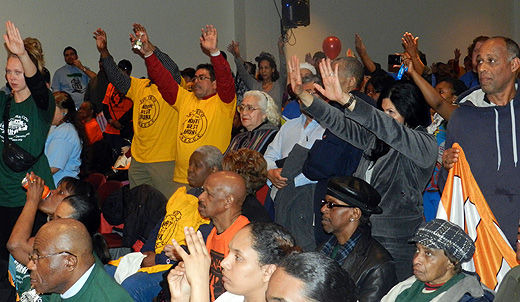
NEW YORK – This is truly a tale of two cities: a city of the very rich, growing richer, and the poor, who are growing poorer. Nowhere is this better seen than in New York City’s affordable housing crisis. In a city with the largest number of billionaires in the world, 60,000 New Yorkers now sleep in homeless shelters every night, 20,000 of them children.
Mayor De Blasio, whose 2013 campaign for mayor was characterized by his vow to address growing inequality in New York City, recently outlined his housing plan in a 2015 State of the City address. He said, “If we do not act-and act boldly-New York risks taking on the qualities of a gated community. A place defined by exclusivity, rather than opportunity. And we cannot let that happen.”
De Blasio’s housing plan
De Blasio outlined an ambitious plan to create 200,00 units of affordable housing by 2024, consisting of 120,000 new and 80,000 preserved or rebuilt ones. He also called on Governor Cuomo and the State legislature to strengthen tenant rent protections.
“The city has for decades let the developers write their own rules,” de Blasio said. “Our growth was guided primarily by the developers’ bottom line.”
On the one hand, his plan would increase the use of an “inclusionary zoning” housing policy that the Bloomberg administration favored. Target areas previously zoned for non-residential or industrial use like the Sunnyside train yards in Queens, Long Island City, South Bronx, and East New York would now be “upzoned” to allow private developers to build housing.
On the other hand, private developers would now be required for the first time to include a percentage – still to be determined-of below market rate units in the mix. To further encourage private developers to build affordable housing, developers would be allowed to increase the height and density of their projects in certain target areas.
140,000 market rate units are also envisioned under the plan. If implemented, it will be the biggest project ever undertaken by City government in its history, the mayor said.
Problems from Albany
De Blasio’s theme of fighting inequality – above all, his sense of urgency in addressing this housing crisis facing working people – is a sharp contrast to the gridlock of the Republican-dominated Congress, and the pro-corporate, anti-tenant, anti-worker agenda recently voiced in his State of the State by Governor Cuomo.
The mayor in his address spoke glowingly of federal-state-city programs in the period after World War II. These assisted labor unions and community groups in organizing housing cooperatives, whether through low cost loans, or through New York State’s Mitchell-Lama housing program.
Rather than following in those footsteps, De Blasio outlined a public-private partnership to address the crisis. The plan would commit by the City $8.2 billion, along with $2.9 billion in anticipated State funds. De Blasio hopes to bolster that investment with $30 billion from private developers.
But if the “magic of the market” was the solution to NYC’s housing affordability crisis, the situation should have been solved long ago. Rather than lowering the cost of housing, a construction boom under former Mayor Bloomberg only caused rents and housing prices to skyrocket. Private developers, assisted by the City’s 421A tax abatement law, have overwhelmingly chosen to build luxury condos, while thousands of working New Yorkers, especially black and Latino, have been displaced.
The sate Government in Albany, which retains legislative say over NYC’s housing policy, is another part of the problem. The historically pro-landlord legislature has long refused to change the “vacancy decontrol” section of the rent regulation law. In the last ten years more than 100,000 rent stabilized apartments have been lost to the market due to this clause, which allows developers to charge market rents once a rent-stabilized unit surpasses $2,500 a month.
The public-private balancing act
De Blasio’s reliance on private developers to build affordable housing involves a balancing act with the real estate industry (at present largely supporting his plan) and his housing activist and tenant supporters, who largely supported his campaign.
Too high a percentage of affordable housing would lead developers to walk away, since to them, as always, the highest rate of profit is paramount. Too low an amount will only serve to increase land values, accelerate gentrification and displacement of New Yorkers.
70 percent of New Yorkers are renters, and over two million New Yorkers spend more than 50 percent of their incomes on rent each month. Over five million spend more than 30 percent (the proportion that the government officially defines as “rent-burdened”). To illustrate the need for affordable housing, 41 “inclusionary zone affordable housing” lotteries last year drew 1.5 million applications for 2,500 new apartments.
The situation is further complicated by the equation that has been commonly used by the government and the real estate industry to determine affordable housing. Average median income of New Yorkers is significantly less than the AMI of the metropolitan tri-state area, through which “affordability” is computed. This has continually led to a surreal situation where trumpeted “affordable” apartments are built, but are out of reach of the residents they have displaced.
Public -private partnerships regarding housing have become common in recent years, as city administrations seek to fill the gap caused by massive cutbacks in federal and state funding.
Certainly some genuinely affordable apartments will be created under De Blasio’s plan. However, we can expect landlords to drive a hard bargain, extorting tax write-offs, abatements and other forms of corporate welfare-as well as insisting on an increasingly flexible definition of “affordable housing” (e.g. Atlantic Yards).
However, we can also expect activists to push in Albany for an end to 421A, as well as an end to vacancy decontrol. We can expect the demand for a substantially higher percentage (e.g. 50 percent of new housing) to be genuinely affordable, for community participation in planning, and for an AMI based on average neighborhood income.
Funding and more
But, whatever the final form, any partnership with the private sector cannot be a substitute for federal-state-city partnership to fund quality affordable housing. Money can be found by taxing Wall Street and the rich, as well as cutting the military budget. If massive tax breaks, abatements and use of eminent domain can be wielded on behalf of the big real estate developers, the same tools can be used by the City to directly create affordable housing and do it much more efficiently.
Infrastructure, community facilities and green space in support of development are crucial. Strengthened rent protections, institution of commercial rent regulation, as well as revitalization and expansion of the City’s public housing (NYCHA) program, must be also part of the mix.
Government-supported and subsidized cooperative housing projects (like those financed through Mitchell Lama), as well as NYC’s public housing program, have long been historic bulwarks against the skyrocketing rents and real estate speculation we see today.
As we fight in Albany and Washington for affordable housing, we must also fight to strengthen these programs: a demand requiring Mitchell-Lama units return to rent stabilization after expiration of their mortgage is one example. We must also fight for initiatives that go beyond the housing-for-profit framework altogether.
De Blasio’s housing plan will continue to be contentious in community board and ULURP hearings between developers, the mayor, the city council, and housing activists in the months ahead.
New Yorkers cannot afford to stand on the sidelines in this fight. Housing should be a right, not a privilege! We need affordable housing now! The outcome is sure to shape the NYC skyline – and the situation of struggling working people – for years to come.
Coalition for Community Advancement
In response to the plan to put between 5,000 and 7,000 new housing units in East New York, community residents and local organizations formed the Coalition for Community Advancement: Progress for East New York and Cypress Hills.
The group’s People’s Platform demands:
1. Creation of affordable housing based on the average income brackets in the neighborhood.
2. Guaranteed policies to prevent displacement and preserve affordability of small homes.
3. Assurance that living wage jobs will result from the rezoning.
4. Commitments to new schools, early childhood centers, higher education facilities and a community center.
5. Improvement of transportation, infrastructure, and safety in our community.
6. Creation of public green and open spaces.
7. Guaranteed full participation and input from the community in the planning process.

MOST POPULAR TODAY


Zionist organizations leading campaign to stop ceasefire resolutions in D.C. area

High Court essentially bans demonstrations, freedom of assembly in Deep South

Afghanistan’s socialist years: The promising future killed off by U.S. imperialism

Communist Karol Cariola elected president of Chile’s legislature






Comments